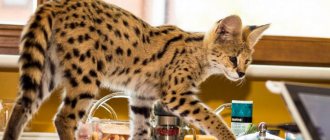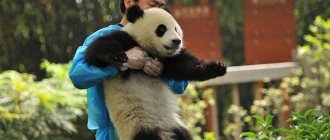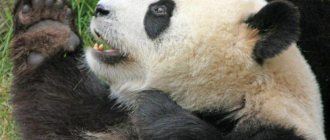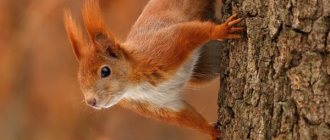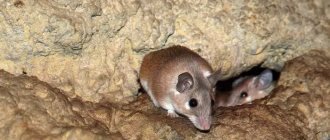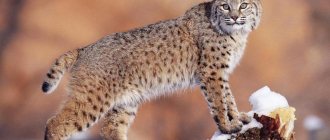One of the cutest and most amazing animals on the planet is the panda. This funny creature, distinguished by its bearish clumsiness, attracts special attention not only from children, but also from adults. There are only two types of these animals found in the world. Let's find out where the beautiful fluffy panda lives, on what continent, as well as many interesting and mysterious things about it.
Big panda
What family does the panda animal, distinguished by its bizarre appearance, belong to? The giant panda belongs to the bear family with certain characteristics of raccoons. These representatives of mammals have a unique wool color. The head is bright white, with black circles around the eye area. The ears, tail, collar and paws, which are small in relation to the massive body, are deep black in color.
The giant panda is distinguished by the special structure of its forelimbs, consisting of 5 main fingers and one more, which is a modified bone. This grasping structure makes it possible to hold bamboo stems and also helps to climb the highest parts of trees.
The giant panda walks on four legs, but has the ability to stand on its hind legs. Because he gets tired quickly, he runs slowly and for short periods of time. But she is an excellent steeplejack and loves to lie down in the branches of trees to rest or to hide from danger.
Animals have a slow behavior with clumsy funny movements and prefer privacy. But when living in zoos, they love to play mischief by playing together, especially at a young age.
Lifestyle and habitat
Both species, as has already been clarified, are residents of Asia, and their favorite habitat is mountain forests, where there is enough food for them. Therefore, animals have a slow character and lead a leisurely, quiet lifestyle, mainly engaged in looking for food and chewing it.
Panda is a nocturnal animal , so during the daytime these creatures indulge in rest, hiding in comfortable tree hollows or other cozy places. Small pandas sleep in a very interesting position: curled up and covering their heads with their long tail.
Both species of animals are able to move through trees with dexterity, but on the ground they seem completely clumsy and feel awkward. Due to these features, if the animals are in danger, they try to hide from pursuit by the enemy by climbing a tree.
Such animals are famous for their funny movements and are extremely cute for their amusing clumsiness. Therefore, if they find themselves in a zoo, they always attract attention. In addition, they have a playful disposition, they love to play mischief and amuse the children.
This behavior is especially typical for young individuals. For these qualities, pandas are officially recognized as the cutest creatures on the planet. And such an honorary title is noted even in the Guinness Book of Records.
In addition, the charm of these animals is adequately appreciated in their homeland, China. In this country they have become the national emblem. And state laws prohibit hunting these animals. It should be noted that this measure is forced and there were good reasons for its introduction.
The fact is that these representatives of the fauna are becoming less and less in the world. According to available information, there were no more than a thousand specimens of giant pandas left in the wild at the end of the last century. Therefore, for the killing of such animals in China, the death penalty was imposed at a certain time.
Things are not so sad with their small relatives, but enhanced measures to protect these creatures are still being taken. Another reason for the decline in the panda population is climate change on the planet.
In view of this, the environment to which they are accustomed continues to exist only in limited areas of the Earth. As a result, cute, cute creatures face complete extinction.
However, despite the strictest prohibitions, the extermination of pandas still continues. And the problem of poaching seems more than serious. And the main attractive factor for hunters should be the beautiful fur of these extremely cute and attractive representatives of the earth’s fauna.
Pregnancy in pandas
The panda is not an animal prone to lively mating games; they have a very low level of fertility. In the spring season, the mating season begins. The duration of pregnancy is 150-160 days. After the set period, the female animal gives birth to a baby that is tiny in relation to the size of the mother. In rare cases, two babies are born. It is quite difficult to recognize these blind, small, almost hairless balls of future chic pandas.
The mother carefully protects her cub, which is prone to fairly rapid growth. Kids are usually too active and very inquisitive. They are in constant search of adventure and entertainment.
The bamboo bear, as the animal is often called, is listed in the Red Book due to its small numbers. In China, the great giant panda symbolizes the national priceless treasure.
How long does a panda live?
A giant panda lives for about 20 years in the wild.
How much does a panda weigh?
The white fluffy panda has a body length of up to 1.8 m, weighs about 160 kg, and also differs from other species of the bear family in its rather long tail, approximately 10-15 cm.
Reproduction
Female pandas become more active during the breeding season and use scent markings. A study conducted between sexually active females and inactive pandas suggests that scent markings relate to sexual activity. Males may compete for a female.
Mating occurs from March to May. The female's estrus lasts approximately 1-3 days. Females lose their previous activity during the period of estrus, become restless and lose their appetite. Most babies are born in late summer and early fall. Pregnancy lasts about 6 weeks. At birth, babies are blind and helpless, and their body is covered with a small layer of fur. The weight of newborns is 85-140 g.
After giving birth, the mother helps the baby lie down in a position comfortable for sucking. The cub can be attached to the mother about 14 times a day, lasting up to 30 minutes per feeding. The cubs open their eyes at 3 weeks of life, move independently at 3-4 months, and are weaned from mother's milk at approximately 46 weeks. The cub remains with its mother for up to 18 months. Giant pandas do not reproduce well in captivity.
When studying the behavior of giant pandas in captivity, it was found that in half of the cases twins are born. The mother, as a rule, gives preference to one of them, and the second soon dies.
Lesser or fire panda
Not everyone knows which family the cute animal the red panda belongs to. So, the dwarf red panda belongs to the panda family from the order of carnivores, and is slightly larger in size than an ordinary cat. The size of its elongated body does not exceed 65 cm, and its weight is from 3.7 to 6.2 kg. The red panda has a fairly wide head with small round ears and a pointed cute muzzle, strong short limbs with half-extended claws, facilitating easy climbing of trees.
The dwarf panda has red fur on the upper parts of the coat and dark brown or black underneath, as well as a white face, black limbs and transverse white rings on the elongated bushy tail.
The peculiar pattern around the eyes of a red panda is similar to a mask, like that of raccoons. It is unique in all individuals and acts as a camouflage, because the red panda spends most of its time on tree branches that are densely covered with thickets of mosses and lichens.
The red panda is nocturnal and thrives at dusk. During daylight hours, she prefers to sleep, hidden in a hollow tree, and loves to curl up in a ball, covering her head with her gorgeous tail. The small red panda moves rather slowly and clumsily on the surface of the earth, but like the big panda, it deftly copes with climbing trees and immediately hides there when danger arises.
There are two subspecies of the red panda - the Staiana red panda and the western red panda. The Staiana panda is a larger animal and darker in color compared to the Western red panda.
A little panda lives about 8-10 years in the wild.
The female fiery red panda breeds her offspring in a pre-arranged nest located in a hollow tree. She is capable of giving birth to 1 to 4 babies, but usually only 1 or 2 of them survive. The red red panda also has low fertility. Little red panda babies grow quite slowly, being near their mother for a long time. The male occasionally takes part in raising his own offspring.
Where does the panda live?
Many people know that this animal is associated with China, but are there other areas where the panda lives? I wonder what continent they are located on? So, the giant panda lives in the mountainous parts of central China, in the provinces of Sichuan and Tibet. These territorial possessions in the form of mountain forests are filled with numerous bamboo thickets. Animals prefer an isolated way of existence, and spend most of their time quietly moving around in order to look for food, systematically chewing it.
Having found out where the giant panda lives, let's move on to the question of where does the fire panda live? So, the distribution zone of the red panda is wider than that of the big panda. In addition to China, the red panda lives in India, Myanmar, Bhutan and Nepal. The habitat of the red panda subspecies is divided. The Western red panda lives in Nepal and Bhutan, while Staiana lives in southern China and northern Myanmar.
Therefore, the region where large and small pandas live can be called Asia east of the Himalayas. First of all, this is expressed by the fact that these regional territories are filled with numerous groves of bamboo, which is the main source of food for animals.
What does a panda eat?
It has been established that the big and small red panda lives on the Eurasian mainland. Now we need to find out what does a panda eat? The basis of the giant panda's nutritional diet is bamboo, and all its parts, including both succulent shoots and roots of the plant.
Oddly enough, having used this particular plant as food for its entire existence on Earth, the animal’s digestive system is not very well able to assimilate it, in contrast to the better digestion of animal food. But eating meat is quite rare for pandas. Occasionally they can eat small mammals and birds, fish, eggs, and other types of plants. But such an addition to food cannot completely replace the absorption of bamboo. Therefore, if the plant dies, the animal risks dying of starvation.
Considering that the panda is still a predator, it can demonstrate its anger towards the intrusive public in zoos, which suspects nothing and is touched by the appearance of a funny animal!
The diet of the red panda from the panda family is almost similar to the diet of its great namesake, but mushrooms also serve as an addition to the food sources obtained. She is a picky eater and prefers the juiciest and freshest parts of bamboo.
We have already found out what the panda mainly eats. Now you need to find out how much food makes up her daily diet? Due to its rather large size, large pandas require a lot of food. Considering how much a panda typically weighs, his daily serving of bamboo could include approximately 30 kg of the plant. This can be compared with the consumption of a person weighing about 75 kg of fresh grass within 15 kg per day. The motivation for such overeating is the poor absorption of bamboo by the animal’s stomach.
Now let’s look at how much food the red panda eats every day. She doesn’t have a lot of weight, so her daily diet dose is smaller. But, if we take the proportional ratio of the size of the red panda to the amount of plant it eats, it turns out that it feeds quite densely, exceeding the saturation capacity of its giant namesake. In total, if there is an abundance of bamboo, the red panda is able to consume over 4 kg of young succulent shoots of the plant, as well as about 1.5 kg of its fresh leaves per day.
Description
In general, giant pandas have a round head, a stocky body and a short tail. The height at the shoulders is 65-70 cm. These animals are well known for their characteristic black and white markings. The limbs, eyes, ears and shoulders are black, while the rest is white. In some regions, the color black actually has a dark red tint. The dark markings around the eyes may be the reason for the popularity of these animals, giving them a naive, juvenile appearance. Enlarged shoulders and neck area along with reduced hindquarters create an ambling gait. The baculum (bone that forms in the connective tissue of the penis) is present in many other mammals. However, in other bears they are straight and pointing forward, while in pandas they are S-shaped and pointing backward. Giant pandas have several skull bone joints. They have a large sagittal crest that is made wider and deeper by their powerful jaws. The molars and small molars are wider and flatter than those of other bears, which is why pandas have developed the ability to crush tough bamboo. A notable feature of these animals is the extra opposable finger on the hand, known as the “panda thumb.” This has caused much confusion in the past when classifying these bears. In fact, it is not a thumb, but a skin protrusion.
Chow bears
Looking at chow chow babies, you might think that these are little bear cubs. But, in reality, they are puppies of this breed, artificially colored so that there is an external resemblance to the cubs of the famous panda. Nowadays it is considered quite a fashionable trend in China, in which fluffy Chow dogs undergo a thorough modification in the form of haircuts and coloring. This manipulation can be performed by any owner for his pet so that he looks like a furry funny bear.
The session takes approximately 2 hours, and the panda disguise lasts only 1.5 months. But the consolation is that the procedure is completely harmless for the animal.
In their natural habitat, animals have no enemies, but, nevertheless, these beautiful creatures of nature are completely unprotected from natural disasters. A huge threat to animals is the period of mass flowering of their favorite bamboo. Being a long-lived plant, it can bloom only once during its entire existence, followed by complete death. With its mass death on huge plantations, pandas are completely left without food. The only salvation for them is migration to other territories where there are areas where their favorite delicacy grows.
Although in modern China there are few natural places left where bamboo grows.
But thanks to their iconic position in the country and unimaginable popularity, pandas are protected from extinction by the investment of huge amounts of money by the Chinese government in a program of strict protection and assistance in breeding these unique animals.
Behavior
Panda behavior
Pandas also differ from other bears in that they do not hibernate in winter, but as winter progresses they descend lower and lower, to the foot of the mountains. Pandas never build holes on their own, hiding in caves. Animals are not only terrestrial - they swim well and climb mountains.
Most often, giant pandas prefer a solitary lifestyle, meeting with individuals of the opposite sex only during the breeding season. Females love to play with their cubs, they get great pleasure from this, and also calm the babies. Sometimes mothers may even wake up the cub to play.
